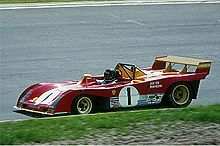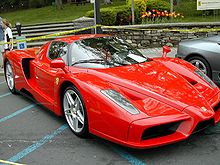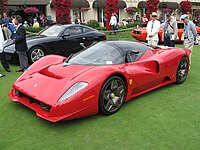| Enzo Ferrari | |
|---|---|
 Enzo Ferrari (left) and Ilario Bandini | |
| Born | February 18, 1898 Modena, Italy |
| Died | August 14, 1988 (aged 90) Maranello, Italy |
| Nationality | Italian |
| Occupation | Founder of Ferrari |
| Children | Alfredo Ferrari Piero Ferrari |
Ferrari S.p.A. is an Italian sports car manufacturer based in Maranello, Italy. Founded by Enzo Ferrari in 1929, as Scuderia Ferrari, the company sponsored drivers and manufactured race cars before moving into production of street-legal vehicles as Ferrari S.p.A. in 1947. Throughout its history, the company has been noted for its continued participation in racing, especially in Formula One, where it has had great success.
 | |
| Type | Società per azioni |
|---|---|
| Industry | Automotive |
| Founded | 1947 (historical 1929) |
| Founder(s) | Enzo Ferrari |
| Headquarters | Maranello, Italy |
| Key people | Luca di Montezemolo Chairman Piero Ferrari Vice Chairman Amedeo Felisa CEO |
| Products | Sports cars |
| Production output | 6,573 units (2010)[1] |
| Revenue | |
| Owner(s) | Fiat S.p.A. 90%[1] |
| Employees | 2,721 (2010)[1] |
| Parent | Fiat S.p.A. |
| Website | Ferrari.com |
History
Enzo Ferrari never intended to produce road cars when he formed Scuderia Ferrari (literally "Ferrari Stable", and usually used to mean "Team Ferrari", it is correctly pronounced [skudeˈriːa]) in 1928 as a sponsor for amateur drivers headquartered in Modena. Ferrari prepared, and successfully raced, various drivers in Alfa Romeo cars until 1938, when he was hired by Alfa Romeo to head their motor racing department.
In 1941, Alfa Romeo was confiscated by the fascist government of Benito Mussolini as part of the Axis Powers' war effort. Enzo Ferrari's division was small enough to be unaffected by this. Because he was prohibited by contract from racing for four years, the Scuderia briefly became Auto Avio Costruzioni Ferrari, which ostensibly produced machine tools and aircraft accessories. Also known as SEFAC (Scuderia Enzo Ferrari Auto Corse), Ferrari did in fact produce one race car, the Tipo 815, in the non-competition period. It was the first actual Ferrari car (it debuted at the 1940 Mille Miglia), but due to World War II it saw little competition. In 1943 the Ferrari factory moved to Maranello, where it has remained ever since. The factory was bombed by the Allies in 1944 and rebuilt in 1946, after the war ended, and included a works for road car production. Until Il Commendatore's death, this would remain little more than a source of funding for his racing operations.

The first Ferrari road car was the 1947 125 S, powered by a 1.5 L V12 engine; Enzo Ferrari reluctantly built and sold his automobiles to fund Scuderia Ferrari.[2]
In 1988, Enzo Ferrari oversaw the launch of the Ferrari F40, the last new Ferrari to be launched before his death later that year, and arguably one of the most famous supercars ever made. From 2002 to 2004, Ferrari introduced the Enzo, its fastest model at the time, in honor of the company's founder: Enzo Ferrari. It was restricted to only the most wealthy automobile enthusiasts, however, as each one cost $1.8 million apiece.
On 17 May 2009 in Maranello, Italy, a 1957 250 Testa Rossa (TR) was auctioned, by RM Auctions and Sotheby's, for $12.1 million — a world record at that time for the most expensive car ever sold at an auction. That record is now held by a Bugatti Atlantic which sold for over $28 million. [3]
Motorsport
- For a complete list of Ferrari racing cars, see List of Ferrari competition cars.

Since the company's beginnings, Ferrari has been involved in motorsport, competing in a range of categories including Formula One and sports car racing through its Scuderia Ferrari sporting division as well as supplying cars and engines to other teams and for one make series.
The 1940 AAC 815 was the first racing car to be designed by Enzo Ferrari, although it was not badged as a Ferrari model.
Scuderia Ferrari
Scuderia Ferrari has participated in a number of classes of motorsport, though it is currently only involved in Formula One. It is the only team to have competed in the Formula One World Championship continuously since its inception in 1950. José Froilán González gave the team its first F1 victory at the 1951 British Grand Prix.
Alberto Ascari gave Ferrari its first Drivers Championship a year later. Ferrari is the oldest team in the championship, and the most successful: the team holds nearly every Formula One record. As of 2008, the team's records include 15 World Drivers Championship titles (1952, 1953, 1956, 1958, 1961, 1964, 1975, 1977, 1979, 2000, 2001, 2002, 2003, 2004 and 2007) 16 World Constructors Championship titles (1961, 1964, 1975, 1976, 1977, 1979, 1982, 1983, 1999, 2000, 2001, 2002, 2003, 2004, 2007 and 2008), 209 Grand Prix victories, 4925.27 points, 622 podium finishes, 203 pole positions, and 218 fastest laps in 776 Grands Prix contested.
Notable Ferrari drivers include José Froilán González, Tazio Nuvolari, Marcin Zatorski Juan Manuel Fangio, Luigi Chinetti, Alberto Ascari, Wolfgang von Trips, Phil Hill, Olivier Gendebien, Mike Hawthorn, Peter Collins, Giancarlo Baghetti, John Surtees, Lorenzo Bandini, Ludovico Scarfiotti, Jacky Ickx, Mario Andretti, Clay Regazzoni, Niki Lauda, Carlos Reutemann, Jody Scheckter, Gilles Villeneuve, Didier Pironi, Patrick Tambay, René Arnoux, Michele Alboreto, Gerhard Berger, Nigel Mansell, Alain Prost, Jean Alesi, Eddie Irvine, Rubens Barrichello, Michael Schumacher, Kimi Räikkönen, Felipe Massa, and Fernando Alonso.
At the end of the 2006 season, the team courted controversy by continuing to allow Marlboro to sponsor them after they, along with the other F1 teams, made a promise to end sponsorship deals with tobacco manufacturers. A five year deal was agreed and although this is not due to end until 2011, in April 2008 Marlboro dropped their on-car branding on Ferrari.
The drivers competing for 2009 were Felipe Massa and defending champion Kimi Räikkönen. As of 2010 Fernando Alonso has started racing for Ferrari after racing for Renault, Minardi and Mclaren, filling Kimi Räikkönen's former seat.
In addition to Formula One, Ferrari also entered cars in sportscar racing, the two programs existing in parallel for many years.
In 1949, Luigi Chinetti drove a 166 M to Ferrari's first win in motorsports, the 24 Hours of Le Mans. Ferrari went on to dominate the early years of the World Sportscar Championship which was created in 1953, winning the title seven out of its first nine years.
When the championship format changed in 1962, Ferrari earned titles in at least one class each year through to 1965 and then again in 1967. Ferrari would win one final title, the 1972 World Championship of Makes before Enzo decided to leave sports car racing after 1973 and allow Scuderia Ferrari to concentrate solely on Formula One.
During Ferrari's seasons of the World Sportscars Championship, they also gained more wins at the 24 Hours of Le Mans, with the factory team earning their first in 1954. Another win would come in 1958, followed by five consecutive wins from 1960 to 1964. Luigi Chinetti's North American Racing Team (NART) would take Ferrari's final victory at Le Mans in 1965.
Although Scuderia Ferrari no longer participated in sports cars after 1973, they have occasionally built various successful sports cars for privateers. These include the BB 512 LM in the 1970s, the 333 SP which won the IMSA GT Championship in the 1990s, and currently the F430 GT2 and GT3 which are currently winning championships in their respective classes.
Race cars for other teams
Throughout its history, Ferrari has supplied racing cars to other entrants, aside from its own works Scuderia Ferrari team.
In the 1950s and 60s, Ferrari supplied Formula One cars to a number of private entrants and other teams. One famous example was Tony Vandervell's team, which raced the Thinwall Special modified Ferraris before building their own Vanwall cars. The North American Racing Team's entries in the final three rounds of the 1969 season were the last occasions on which a team other than Scuderia Ferrari entered a World Championship Grand Prix with a Ferrari car.[4]
Ferrari supplied cars complete with V8 engines for the A1 Grand Prix series, from the 2008-09 season.[5] The car was designed by Rory Byrne and is styled to resemble the 2004 Ferrari Formula one car.
The 599 GTB Fiorano and F430 GT are used in GT racing series. The Ferrari Challenge is a one make racing series for the Ferrari F430. Ferrari's latest supercar, the 2006 FXX is not road legal, and is therefore only used for track events.
Road cars
- For a complete list, including future and concept car models, see List of Ferrari road cars.

Current models
| California | 458 Italia | 599 GTB Fiorano | FF |
|---|---|---|---|
|
|
|
|
 |  |  |  |
Ferrari's first vehicle was the 125 S sports/racing model. In 1949, the Ferrari 166 Inter, the company's first move into the grand touring market, which continues to make up the bulk of Ferrari sales to the present day.
Several early cars featured bodywork customised by a number of coachbuilders such as Pininfarina, Zagato and Bertone.
The Dino was the first mid-engined Ferrari. This layout would go on to be used in most Ferraris of the 1980s and 1990s. V8 Ferrari models make up well over half of the marque's total production.
For a time, Ferrari built 2+2 versions of its mid-engined V8 cars. Although they looked quite different from their 2-seat counterparts, both the GT4 and Mondial were closely related to the 308 GTB.
The company has also produced front-engined 2+2 cars, culminating in the current 612 Scaglietti and California.
Ferrari entered the mid-engined 12-cylinder fray with the Berlinetta Boxer in 1973. The later Testarossa remains one of the most famous Ferraris.
Supercars
The company's loftiest efforts have been in the supercar market. The 1962 250 GTO may be considered the first in the line of Ferrari supercars, which extends to the recent Enzo Ferrari and FXX models.
Concept cars and specials
Ferrari has produced a number of concept cars, such as the Ferrari Mythos. While some of these were quite radical (such as the Ferrari Modulo) and never intended for production, others such as the Ferrari Mythos have shown styling elements which were later incorporated into production models.
The most recent concept car to be produced by Ferrari themselves was the 2010 Ferrari Millechili.
A number of one-off special versions of Ferrari road cars have also been produced, some of which have been commissioned by wealthy owners. One of the examples is the Ferrari P4/5.
The Special Projects program is a collaboration by Ferrari with Italian automobile coachbuilders such as Fioravanti, Pininfarina, and Zagato to build custom cars using selected Ferrari models as a structural base. The first car under this program is the SP1, commissioned by a Japanese business executive. The second is the P540 Superfast Aperta, commissioned by an American enthusiast.
Bio-fuel and hybrid cars
Ferrari has considered making hybrids. A F430 Spider that runs on ethanol was displayed at the 2008 Detroit Auto Show. Ferrari has announced that a hybrid will be in production by 2015. At the 2010 Geneva Motor Show, Ferrari unveiled a hybrid version of their flagship 599. Called the "HY-KERS Concept", Ferrari's hybrid system adds more than 100 horsepower on top of the 599 Fiorano's 612 HP.[6]
Naming conventions
Until the early 1980s, Ferrari followed a three-number naming scheme based on engine displacement:
- V6 and V8 models used the total displacement (in decilitres) for the first two digits and the number of cylinders as the third. Thus, the 206 was a 2.0 L V6 powered vehicle, while the 348 used a 3.4 L V8, although, for the F355, the last digit refers to 5 valves per cylinder. Upon introduction of the 360 Modena, the digits for V8 models (which now carried a name as well as a number) refer only to total engine displacement. The numerical indication aspect of this name has carried on to the current V8 model, the F430. The F430's replacement, however, is the 458 Italia, which uses the same naming as the 206 and 348.
- V12 models used the displacement (in cubic centimetres) of one cylinder. Therefore, the famed 365 Daytona had a 4390 cc V12. However, some newer V12-engined Ferraris, such as the 599, have three-number designations that refer only to total engine displacement.
- Flat 12 (boxer) models used the displacement in litres. Therefore, the BB 512 was five litre flat 12 (a Berlinetta Boxer, in this case). However, the original Berlinetta Boxer was the 365 GT4 BB, which was named in a similar manner to the V12 models.
- Halo Car F followed by the anniversary in years, such as the F40 and F50. The Enzo skipped this rule, but it will return in the upcoming F70.
- Some models, such as the 1980 Mondial and the 1984 Testarossa did not follow a three-number naming scheme.

Most Ferraris were also given designations referring to their body style. In general, the following conventions were used:
- M ("Modificata"), placed at the end of a model's number, denotes a modified version of its predecessor and not a complete evolution (see F512 M and 575 M Maranello).
- GTB ("Gran Turismo Berlinetta") models are closed Berlinettas, or coupes.
- GTS ("Gran Turismo Spyder") in older models, are open Spyders (spelt "y"), or convertibles (see 365 GTS/4); however, in more recent models, this suffix is used for targa top models (see Dino 246 GTS, and F355 GTS; the exception being the 348 TS, which is the only targa named differently). The convertible models now use the suffix "Spider" (spelt "i") (see F355 Spider, and 360 Spider).
- GTO ("Gran Turismo Omologata"), placed at the end of a model's number, denotes a modified version of its predecessor. Indeed, those three letters designate a model which has been designed and improved for racetrack use while still being a street-legal model. Only three models bear those three letters; the 250 GTO of 1962, the 288 GTO of 1984 and the 599 GTO of 2010.
This naming system can be confusing, as some entirely different vehicles used the same engine type and body style. Many Ferraris also had other names affixed (like Daytona) to identify them further. Many such names are actually not official factory names. The Daytona name commemorates Ferrari's triple success in the February 1967 24 Hours of Daytona with the 330 P4.[7] Only in the 1973 Daytona 24 Hours, a 365 GTB/4 model run by NART (who raced Ferrari's in America) ran second, behind a Porsche 911.[8]





No comments:
Post a Comment